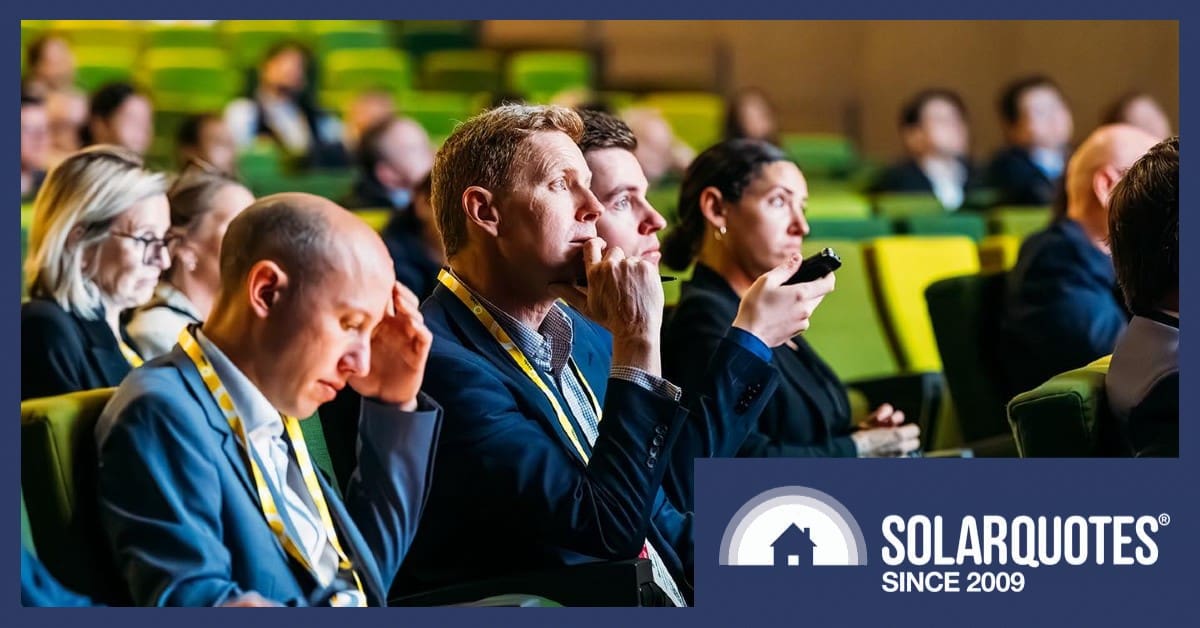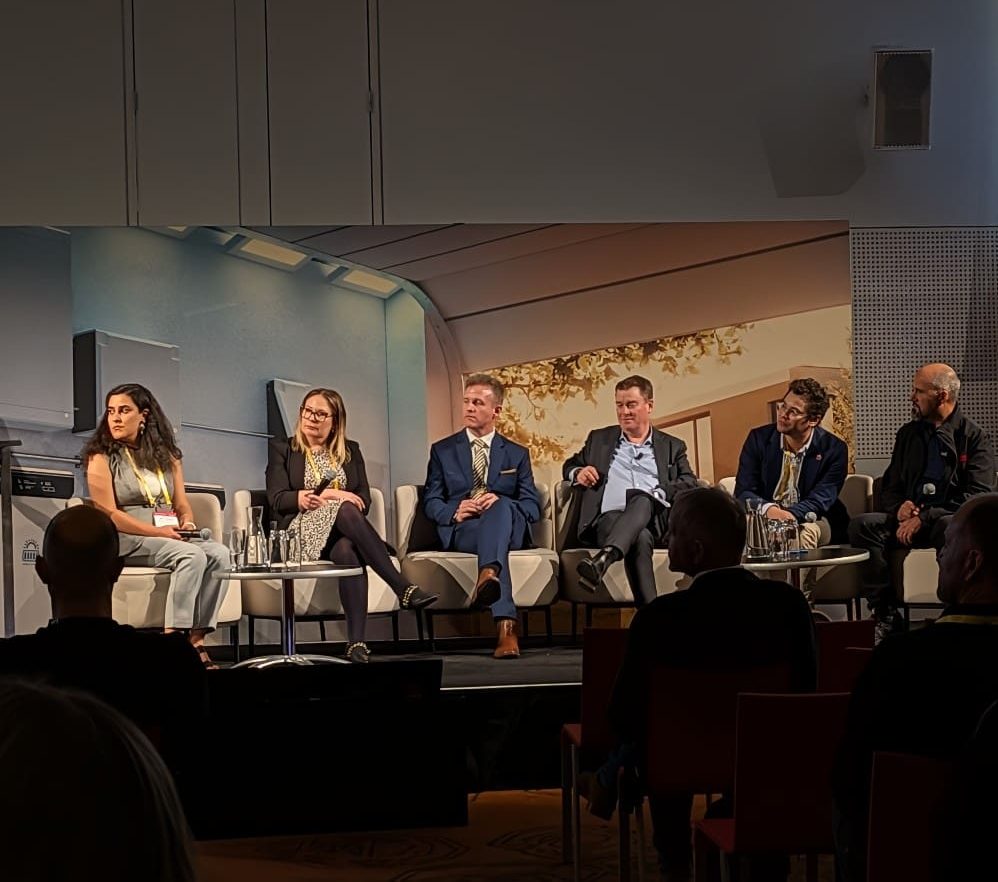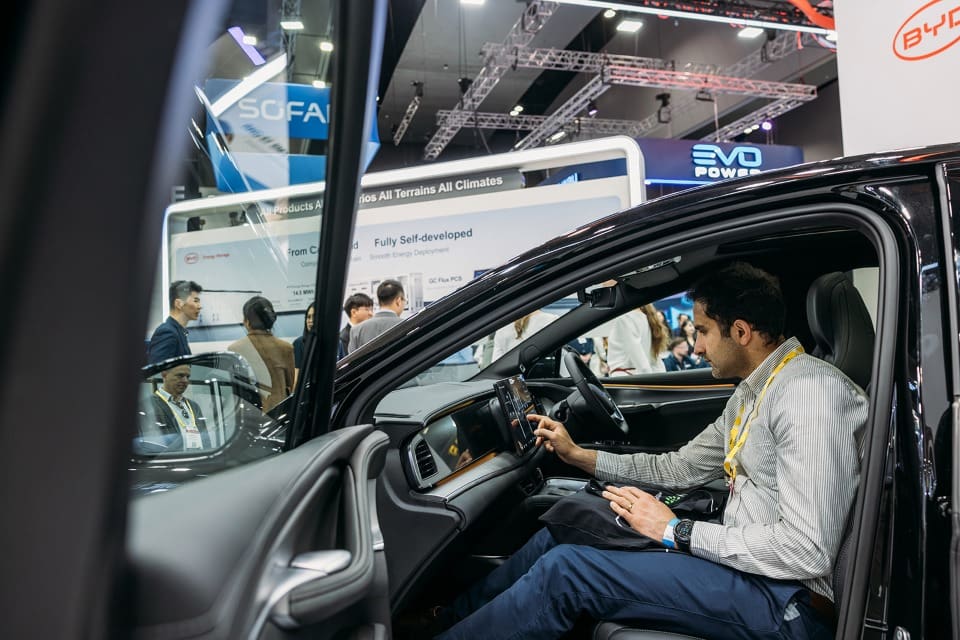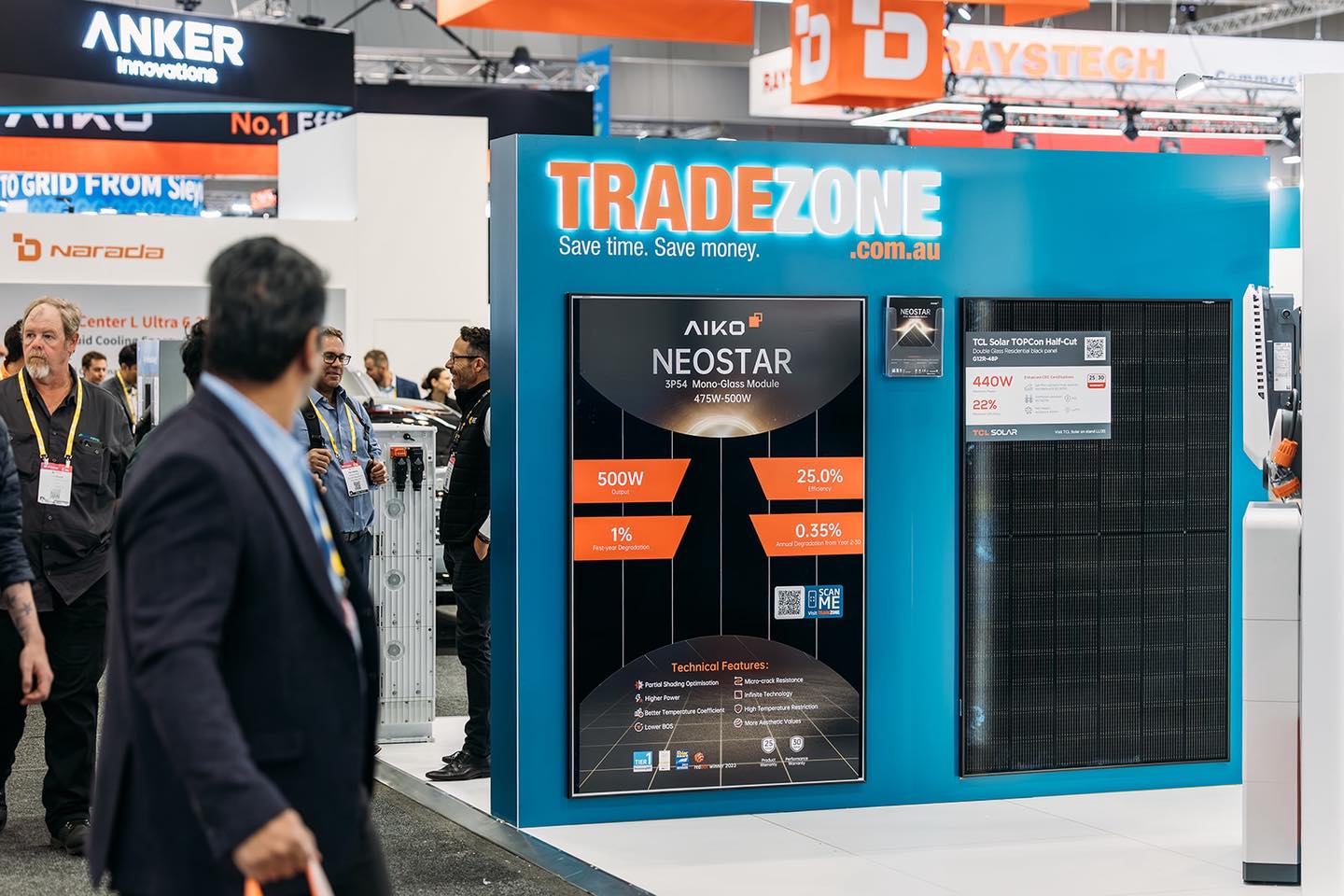 Thousands have converged on Melbourne to address the opportunities and growing pains of the solar battery bonanza, in the first All Energy Australia conference since the introduction of the federal rebate. The SolarQuotes team joined the fray to cover the Southern Hemisphere’s largest clean energy event, which ran over two days from October 29 to 30.
Thousands have converged on Melbourne to address the opportunities and growing pains of the solar battery bonanza, in the first All Energy Australia conference since the introduction of the federal rebate. The SolarQuotes team joined the fray to cover the Southern Hemisphere’s largest clean energy event, which ran over two days from October 29 to 30.
What Was On The Agenda At All Energy Australia?
From the dazzling array of companies spruiking home energy storage on the exhibition floor to the heavyweight speakers exploring the topic on conference stages, the national battery frenzy was on full display.
One of the first of the 500+ speakers scheduled to present was Carl Binning, Executive General Manager of the Clean Energy Regulator’s Scheme Operations Division, who said that over 100,000 batteries had been installed since the launch of the rebate on July 1.
“We think we’ll get to about 160,000 by the end of the year, our run rate is … about 8000 applications per week. If we keep running at that rate, we’ll go from two gigawatt hours of storage to three and a half gigawatt hours of storage by the end of 2025,” he said.
Binning added that while the scale of demand means wait times for orders now typically exceed three months, 100-odd battery installers are coming on board each week as the sector scrambles to catch up with demand.
Concerns Over Battery Install Quality & Accessibility
Ashley Smith, Assistant Manager of the Small-scale Renewable Energy Scheme, Inspections & Regulation, told a Clean Energy Council Masterclass that his team had undertaken “just under 200 inspections to date” on batteries installed under the rebate, of which over half had “substandard installation practices”. Smith said his agency would be adjusting its approach to quash the issues.
“Our goal is to reduce battery system non-compliance to 20% of the load. To achieve this, we’re going to introduce a few new controls with collective engagement with state and territory regulators. [One focus is on] clear imagery showing the marking of back up circuits, warning labels and emergency service disks … this will require a collective effort across the industry to help force this down,” he said.
Another issue is that even with the rebate, only some Australians are in a position to cut their energy bills through batteries.
Elham Hajhashemi, Manager of Analysis and Advocacy at Energy Consumers Australia, said research currently being undertaken by her organisation indicated one-in-three households were more likely to get a battery due to the rebate.
“But for half of households, they say the rebate doesn’t make any change for them … a lot of them might be in rental units or apartments … or the upfront cost might be hard,” Hajhashemi said.
Virtual Power Plant Uptake Lagging

A panel of speakers for the All Energy Australia session: The Future of Home Energy Storage: Unlocking Opportunities and Overcoming Challenges.
James Sturch, Technical Director at SolarEdge, told the conference that although Australians are installing a huge amount of home energy systems, not enough are joining a Virtual Power Plant (VPP) to allow that storage to be coordinated well enough to meet forecast future demands for the grid.
Sturch said consumers were reluctant to sign on to VPPs due to a lack of trust of the energy industry and the bewildering array of different products available, with a need to simplify offerings.
“According to New South Wales, when you look at the battery install rates since the rebate, they’ve gone up six fold. But then when you look at the amount of people signing up to VPPs through the PDRS, it’s only tripled, which actually tells you that the [proportion of battery owners] signing up for VPPs has halved … [VPPs] are all structured so differently. Some do this, and some do that, and some have this rate and some have that rate, and some require you to have a certain reserve for VPP aggregation. It is incredibly confusing for consumers,” he said.
Batteries On Wheels

EV manufacturer BYD was present both on the exhibition floor and onm the conference stage.
Harnessing the energy stored in electric vehicles was another hot topic, with discussions held on how to make Vehicle-to-Grid (V2G) exports from EVs a meaningful contributor to the grid.
Julie Delvecchio, CEO of the Electric Vehicle Council, expressed enthusiasm about the possibilities of EVs being used as mobile storage, noting that in “the first six months of this year, 72,000 Australians got into an electric vehicle – a 24% increase on the same period the previous year.”
She cautioned however that consumer literacy around V2G remains low, with her organisation’s research indicating only 10% of Australians can explain what it is.
“Organizations that have never really traditionally worked together – car manufacturers, energy networks, energy retailers, they don’t have a lot in common, and they’re having to come together to find innovative ways of removing that complexity for customers. And I think the exciting part of that is that we’re seeing trials in market right now. So Origin Energy (the owner of SolarQuotes), AGL, they have products in the market that are doing trials on these very things, and I think the more we can show how it works … the more I think we’ll see people make the connection between this technology and how it can save.”
One V2G trial underway in Australia is Amber Electric’s initative with ARENA. The company used the All Energy spotlight to reveal that BYD Automotive would warrant 50 Amber customers’ EVs as part of the trial, in a bid to tackle the key issue of many EV warranties being rendered void if V2G charging is undertaken.
Harry Li, Product Engineering Manager at BYD, declared Australia is “undoubtedly the best country for V2G”, and that the trial would help the company figure out a reasonable warranty for V2G, with the technology promising offset consumer concerns about EV depreciation in a fast-evolving market by letting them export to the grid for a profit.
“We’re going through a very volatile time where technologies are advancing so quickly, where every two or three years there are big breakthroughs in this EV space. So by having technologies like V2G and V2L, we’re giving customers more reasons to make that leap into an EV. For the first time, I think customers will be able to make money from their vehicles instead of losing money due to depreciation,” Li said.
Plenty Of Hardware On Show
Among the 450+ suppliers in attendance, a raft of manufacturers took the opportunity to launch new product lines, including GoodeWe’s new ESA all-in-one home battery systems, Aiko’s claim of a world-first 500 W panel under 2m², and TrinaSolar’s new generation of Vertex S+ high-power solar panels.
Browsing the gear spruiked on the exhibition floor were many of SolarQuotes’ network of installers, who were invited to attend the inaugural SolarQuotes Awards in Melbourne on the eve of All Energy, where we revealed Australia’s top installer of 2025.
Sign up for our free weekly newsletter to get emailed a full rundown of our coverage of All Energy Australia delivered next Tuesday.


 RSS - Posts
RSS - Posts



With the text in the above article;
”
Harnessing the energy stored in electric vehicles was another hot topic, with discussions held on how to make Vehicle-to-Grid (V2G) exports from EVs a meaningful contributor to the grid.
”
the significant question arises – what proportion of BEV’s being sold in Australia, have V2H (more important than V2G) capacity?
How many models?
The manufacturers of BEV’s are pretty backward about providing vehicles that have power exporting functionality.
Geely can’t be bothered with Australia, with its RD6 ute with 16kW V2L, simply being clickbait in this country.
BEV light cargo vans – being promoted for tradies, lack V2L, which is a pretty useless design fault, in these times. If a tradie is to buy a BEV van, then, needs to supplement it with a petrol generator to power power tools, what use is that?
Whilst, in Australia, the grid operators stuff around regarding clean energy, the BEV manufacturers stuff around with V2L and V2H.
The BYD T3 had V2L.
Your dead right the rd6 has certainly just been clickbait, would have been a good seller to i reckon !!
The new Farizon vans have 3.6 kW V2L
What are the pricing and specifications of the Farizon vans?
If there really is an unsatisfied wish for more home battery owners to contribute to grid firming, then the solution does seem to be transparently obvious:
1) Pay more for the generation, storage, and resulting grid-beneficial time-shifting. (VPP operator margins need to be negligible for them to have a place in the NEM.)
2) Make the supply agreement dead set simple – definitely not more than one page of clear concise operating principles, stating owner’s energy reserve, maximum cycling rate, 100% owner’s take for tariff peaks, etc.
Deferment of grid upgrades, as home batteries reduce demand peaks, is a great benefit, as is the contribution to earlier elimination of coal power plants. If domestic energy investors are to even further support the grid, then just reduce the “buy retail but sell wholesale” exploitation gap.
I’m off-grid, so no skin in the game, but buyers need to increase price offers when demand exceeds supply. Simples.
With Sodium batteries, half, of the price and as good, as lithium iron phosphate batteries, going into mass production, in a month. Other battery factories convertible, from lithium to sodium, when these batteries become available. They’ll be unsubsidised, the same price per kWh, as they are subsidised now.
Sodium batteries can also handle the cold, last for 70 years, the new Chinese standards, are so strict, on fire safety, they’re 1,000 times safer, than hydrocarbon vehicles.
With the RD6 ute having been withheld from sale in Oz (with the RD6 having been said to extinguish HiLux sales, upon being sold in Oz, I wonder whether benefits were provided to cause the RD6 to be withheld from sale in Oz, to protect HiLux sales), and with SAIC/LDV disincentivizing Ozzies from buying the eT60 (which was selling for about 105K AUD when it was selling for about 40K NZD (about 35K AUD) in the land of the long white ICE vehicles exhaust smoke cloud, after the cartel ruling the country, determined that kiwis (both the feathered birds and the unfeathered mammals) should be extinctified through getting high on ICE vehicle fumes and tobacco smoke), by extinguishing the clean vehicles incentives and pushing tobacco smoking, and, with the Chery E5 being sold in the technologically advanced country of Mynamar, with V2L, but, Oz getting only the reject E5’s in which the robots forgot to install V2L; and, with the lack of BEV models in Oz The prospects for V2X in Oz are not good.
Rd6 not being sold here does sound a bit fishy, pity byd don’t have something similar !!
The policy of BYD toward Australia, is not good.
The BYD T3 cargo van (like a BEV equivalent of the Suzuki Carry van) that was sold in Australia, was supplied by BYD with only 100 vehicles, and, only in the cargo van model. After sales support was apparently, shockingly bad. The BYD T3 cargo van came with V2L and a full size spare wheel. At the time, it was the cheapest BEV available in Australia. In the more technologically advanced countries, such as Nepal, Indonesia and the Philippines (and even England), the T3 was available also as a 5 seater passenger van, which came with a spare wheel, and, in a 7 seat passenger version (that was not supplied by default wit a spare wheel), that is named the M3 model. But, BYD determined that Australians should not be allowed to buy BEV passenger vans, only the cargo van model, and, with a maximum of 100 vehicles of the cargo van, for the whole country, being sold only in Sydney (as new vehicles). A WA man had to drive his from Sydney to WA.
“the lack of BEV models in Oz” should have been “the lack of BEV models with V2H, in Oz”).
However, manufacturers are also, definitely depriving Oz of many BEV models that are available in the much more technologically advanced countries like Nepal,Indonesia, the Philippines, lower and central Africa, and England.
Another consideration regarding the text in the above article;
”
Harnessing the energy stored in electric vehicles was another hot topic, with discussions held on how to make Vehicle-to-Grid (V2G) exports from EVs a meaningful contributor to the grid.
”
is this; with the SRES scheme having been expanded to include stationary household batteries up to 50kWh, a possibility is for BEV’s with V2H, to be also included in the SRES scheme, with a subsidy per kWh of usable battery battery capacity, up to 50kWh, and, where a BEV has V2L, given the applicability of the HOEM system (https://www.solarquotes.com.au/blog/hoem-review/), BEV’s with V2L, could be subsidised on a pro-rata basis, through the SRES scheme, , in that, in Australia, a single phase household grid connection generally allows 14.3kW of power transfer, the pro-rata SRES subsidy applicable to BEV’s with V2L, could be ( (BEV V2L capacity) / 14.3) * (SRES rate for stationary household battery usable capacity up to 50kWh) )
Yes good idea another way to help fix the duck curve !!